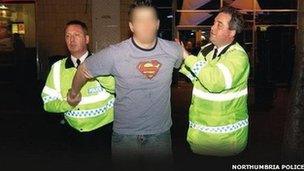'Community resolutions' used in 10,000 serious violence cases
- Published

Unlike a caution, a community resolution does not lead to a criminal record
More than 10,000 serious violent crimes were dealt with informally last year, despite guidelines to the contrary.
Police used "community resolutions", which can include an apology or compensation to the victim, instead of prosecutions and cautions.
The Association of Chief Police Officers says resolutions should only be used for low-level crime.
The data came from 33 police forces in England and Wales which responded to a Freedom of Information request.
It was analysed by the House of Commons library after being obtained by the Labour Party.
BBC home affairs correspondent Danny Shaw said police were increasingly being encouraged to deal with minor incidents informally to reduce the burden on the criminal justice system.
This approach is known as a community resolution and it can involve restorative justice techniques, such as the offender apologising to the victim, paying compensation or repairing any damage caused.
Unlike a caution, a community resolution does not lead to a criminal record.
The Association of Chief Police Officers (Acpo) advises in guidelines that community resolutions should be used for "less serious" offences which may include "minor assaults without injury".
But last year a community resolution was applied in 10,160 incidents of "serious violence" - about 12 times the figure for five years ago, the figures obtained by Labour show. They were also used in 2,488 domestic violence cases in 2012.
In total, community resolutions were used 33,673 times for violence against the person offences last year.
The figures do not include cases where restorative justice is used after an offender has been cautioned or convicted.
The number of community resolutions being issued in cases of violent crime has risen from 7,621 in 2010 to 8,523 in 2011. However, the figures show the largest increase was from 792 in 2008 to 5,173 in 2009.
Incidents classed as serious violence by the House of Commons library in its analysis include:
Grievous bodily harm (GBH) with intent
GBH without intent
Assault occasioning actual bodily harm
Malicious wounding
Wounding with intent to do grievous bodily harm
Use of substance or object to endanger life
Shadow home secretary Yvette Cooper said the figures were "extremely serious".
There had been "a massive increase in the number of serious and violent crimes dealt with just by community resolution ever since the police cuts started - breaking all the expert guidance and promises from ministers", she said.
"Offenders who admit to serious and violent crimes - including knife crime, domestic violence and serious assault - are increasingly being let off with no criminal record, no justice and not even a caution.
"That's bad for justice, bad for victims and goes against all the evidence."
Peter Neyroud, former chief constable of Thames Valley Police, told the BBC that three conditions had to be met for restorative justice to be an option - low-harm offence, the offender had to accept his or her guilt and the victim had to consent.
He said some cases which used restorative justice "didn't look right" and he expressed particular concern about domestic abuse incidents, saying there was an issue with the "genuineness of consent".
Former chief constable of Thames Valley Police Peter Neyroud and Acpo's Assistant Chief Constable Garry Shewan
Mr Neyroud said there was concern the resolutions were being used as a quick way of clearing up a case.
"That concern has to be increased when you have falling numbers of police officers on the street who are feeling under pressure," he added.
"That was one of the reasons why Yvette Cooper asked the question - she had heard an incidence of a police officer doing a community resolution because it was a convenient way of closing off the job and moving on."
'Victim-led'
A Home Office spokesman said it was the responsibility of chief constables to ensure community resolutions were used appropriately.
"Through crime maps and police and crime commissioners, the public now have the means to hold them to account," he added.

Acpo's Assistant Chief Constable Garry Shewan said guidelines were in place to help forces decide where the use of community resolutions might be appropriate.
"But in every case, this decision will be victim-led and above all reflect their views and wishes," he said.
"At times it may be necessary, and appropriate, to use such informal resolutions to deal with more serious cases.
"Going through a restorative justice meeting has also been proven to have more impact on an offender than a prison sentence or a court punishment alone, as they see the consequences of their actions and so want to make changes in their future behaviour."
The Restorative Justice Council - "the national voice for restorative practice" - said it should be "available for all victims of crime who want it, subject to a risk assessment by a trained restorative justice professional".
Incidents which are dealt with by community resolution are still recorded as crimes, so there is no impact on the crime figures.
- Published30 April 2013
- Published30 April 2013
- Published24 April 2013
- Published24 April 2013
- Published14 March 2013
- Published20 October 2012